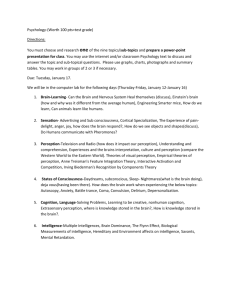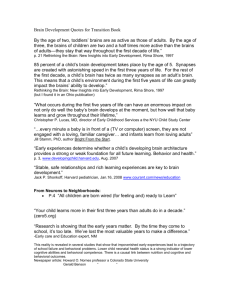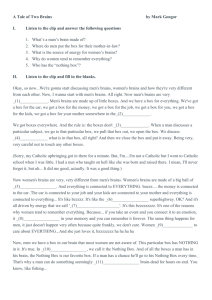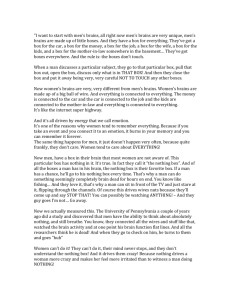ynamics in the genesis of trust ... communication by representations.
advertisement
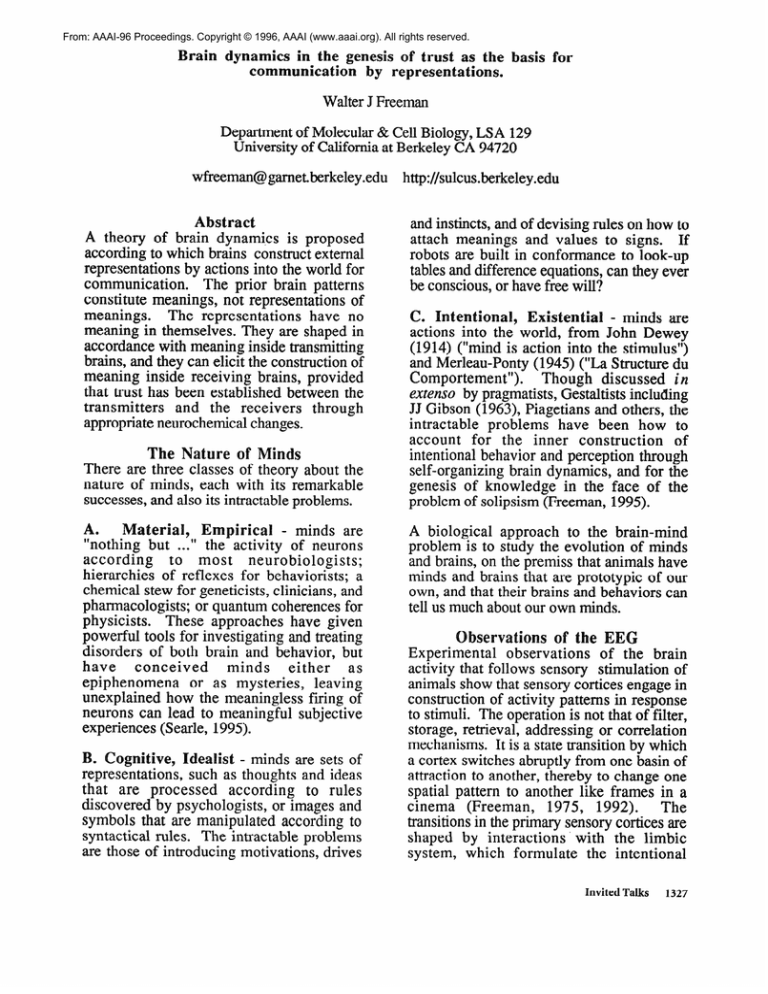
From: AAAI-96 Proceedings. Copyright © 1996, AAAI (www.aaai.org). All rights reserved. ynamics in the genesis of trust as the basis for communication by representations. Walter J Freeman Department of Molecular & Cell Biology, LSA 129 University of California at Berkeley CA 94720 wfreeman@garnet.berkeley.edu Abstract A theory of brain dynamics is proposed according to which brains construct external representations by actions into the world for communication. The prior brain patterns constitute meanings, not representations of meanings. The representations have no meaning in themselves. They are shaped in accordance with meaning inside transmitting brains, and they can elicit the construction of meaning inside receiving brains, provided that trust has been established between the transmitters and the receivers through appropriate neurochemical changes. The Nature of IIdS There are three classes of ory about the nature of minds, each with its remarkable successes, and also its intractable problems. A. Material, Empirical - minds are “nothing but . ..‘I the activity of neurons according to most neurobiologists; hierarchies of reflexes for behaviorists; a chemical stew for geneticists, clinicians, and pharmacologists; or quantum coherences for physicists. These approaches have given powerful tools for investigating and treating disorders of both brain and behavior, but have conceived minds either as epiphenomena or as mysteries, leaving unexplained how the meaningless firing of neurons can lead to meaningful subjective experiences (Searle, 1995). Cognitive, Idealist - minds are sets of such as thoughts and ideas representations, that are processed according to rules discovered by psychologists, or images and symbols that are manipulated according to syntactical rules. The intractable problems are those of introducing motivations, drives http://sulcus.berkeley.edu and instincts, and of devising rules on how to attach meanings and values to signs. robots are built in conformance to look-up tables and difference equations, can they ever be conscious, or have free will? ntentional, Existentia actions into the world, from John Dewey (1914) (“mind is action into the stimulus”) and Merleau-Ponty (1945) (“La Structure du Comportement”). Though discussed in extenso by pragmatists, Cestaltists including JJ Gibson (1963), Piagetians and others, the intractable problems have been how to account for the inner construction of intentional behavior and perception through self-organizing brain dynamics, and for the genesis of knowledge in the face of the problem of solipsism (Freeman, 1995). A biological approach to the brain-mind problem is to study the evolution of minds and brains, on the premiss that animals have minds and brains that are prototypic of our own, and that their brains and behaviors can tell us much about our own minds. servations of t Experimental observations of the brain activity that follows sensory stimulation of animals show that sensory cortices engage in construction of activity patterns in response to stimuli. The operation is not that of filter, storage, retrieval, addressing or correlation mechanisms. It is a state transition by which a cortex switches abruptly from one basin of attraction to another, thereby to change one spatial pattern to another like frames in a cinema (Freeman, 1975, 1992). The transitions in the primary sensory cortices are shaped by interactions with the limbic system, which formulate the intentional Invited Talks 1327 nature of percepts. They result from goaldirected actions in time and space. Each transition involves learning, so that cumulatively a trajectory is formed by each brain over its lifetime. Each spatial pattern as it occurs reflects the entire content of individual experience. It is a meaning and not the representation of a meaning. It is the basis for consciousness. Inferences made from EEG studies about the nature of meaning are as follows. Brains are open with respect to energy and information, but closed systems with respect to meaning. Brains create their own frames of reference, and can have no direct communication, such as by ESP. Each consciousness is isolated from all others. Brains have no direct access to the physical world. All perceptions are constructs from raw sensory input. Intentionality is texture and context in the dynamical structure of space-time memory. It is based in a neural net by neurochemical modulations of synapses and trigger zones. Meanings are places in this structure. A Theory of Representation Four findings led to these conclusions and the demise of a theory of representations in the experiments designed to test (Freeman, 1983; Skarda and Freeman, 1987): 1, The EEG spatial amplitude patterns observed during training lacked invariance with respect to the conditioned stimuli over time and learning. 2. The EEG spatial patterns in the control periods reflected the null hypothesis and not the specific expectations that had been established by training. 3. The EEG phase patterns did not show a requisite convergence to synchrony (“binding”) with arrival of expected stimuli. 4. The EEG phase patterns did manifest the repeated nonlinear state transitions that enable the sensory cortices to construct the spatial patterns of amplitude appropriate for the conditioned stimuli and conditioned responses. A Theory 1328 AAAI-96 of Trust It follows that each brain creates its own frames of reference, which are not directly accessible by any other brain.- IIow, then, can two or more brains be shaped by learning, so as to form cooperative pairs for reproduction and groups for survival? Evolution has provided a biological mechanism that first came under scientific scrutiny in the form of Pavlovian ‘brain washing’. Under now well known conditions of stress in the internal and external environments, a global transition takes place, following which brains sustain a remarkable period of malleability (Freeman, 1995). I believe that Pavlov manipulated a mammalian mechanism of pair bonding, for the nurture of altricial young through sexual orgasm and lactation, mediated by oxytocin, and that our remote ancestors evolved to adapt this mechanism for tribal bonding through dance, chanting, rituals, and evangelical conversions (Sargant 1957). These dimensions of human experience can be encompassed by a neurodynamical theory of intentionality, but not by theories of representation and symbol manipulation. References Dewey J (1914) Psychological doctine in philosophical teaching. Journal of Philosophy 11: 505-5 12. Freeman WJ (1975) Mass Action in the Nervous System. New York: Academic. Freeman WJ (1983) The physiology of mental images. Biological Psychiatry 18:1107-1125. Freeman WJ (1992) Tutorial in Neurobiology. International Journal of Bifurcation and Chaos 2: 451-482. Gibson JJ (1979) The Ecological Approach to Visual Perception. Boston: Houghton Mifflin. Freeman WJ (1995) Societies of Brains. Hillsdale NJ, Lawrence Erlbaum. Merleau-Ponty M (1942/1963) The Structure of Behavior (AL Fischer, Trans.). Boston: Beacon Press. Sargant W (1957) Battle for the Mind. Westport CT, Greenwood Press. Searle JR (1995) The Mystery of Consciousness. New York Rev 2-18 Nov, Skarda CA and Freeman WJ (1987) How brains make chaos in order to make sense of the world. Behav. & Brain Sci. 10: 161- 195.

